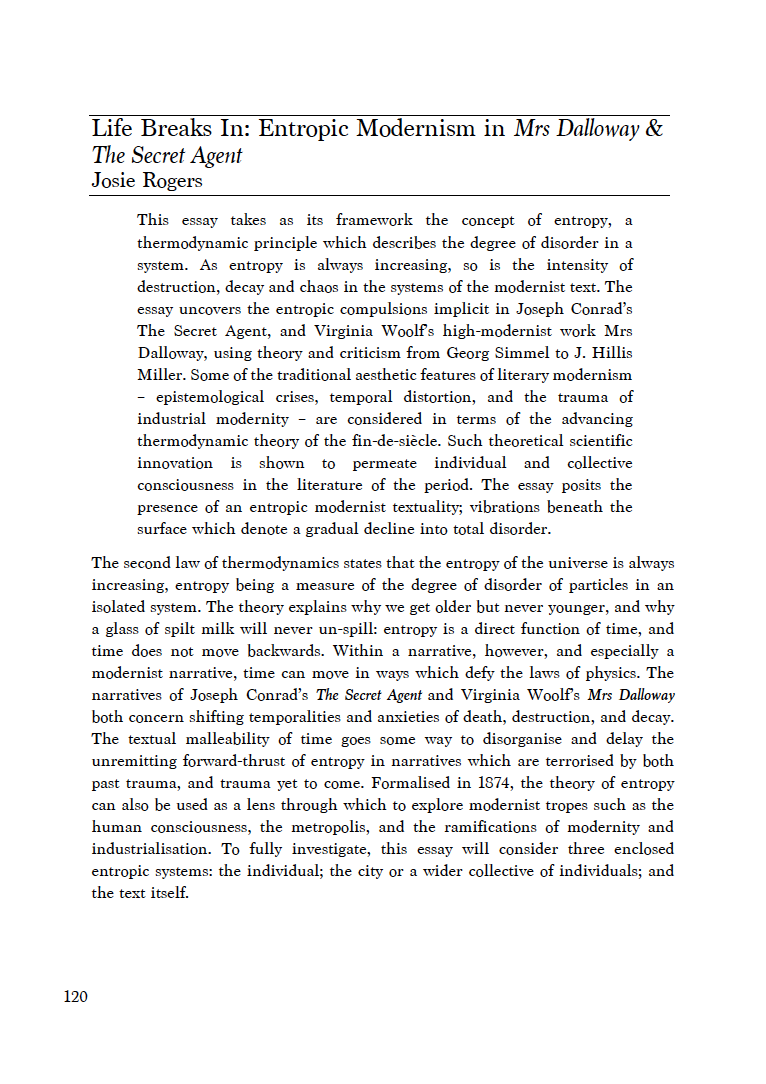Life Breaks In
Entropic Modernism in Mrs Dalloway & The Secret Agent
DOI:
https://doi.org/10.36399/GroundingsUG.10.192Keywords:
Entropic Modernism, Virginia Woolf, Modernism, Mrs Dalloway, The Secret Agent, Joseph Conrad, TextualityAbstract
This essay takes as its framework the concept of entropy, a thermodynamic principle which describes the degree of disorder in a system. As entropy is always increasing, so is the intensity of destruction, decay and chaos in the systems of the modernist text. The essay uncovers the entropic compulsions implicit in Joseph Conrad’s The Secret Agent, and Virginia Woolf’s high-modernist work Mrs Dalloway, using theory and criticism from Georg Simmel to J. Hillis Miller. Some of the traditional aesthetic features of literary modernism – epistemological crises, temporal distortion, and the trauma of industrial modernity – are considered in terms of the advancing thermodynamic theory of the fin-de-siècle. Such theoretical scientific innovation is shown to permeate individual and collective consciousness in the literature of the period. The essay posits the presence of an entropic modernist textuality; vibrations beneath the surface which denote a gradual decline into total disorder.
References
U. Boccioni et al.,‘Futurist Painting: Technical Manifesto’ in Umbro Apollonio (ed.), Futurist Manifestos (London, 2009).
R. Chambers, An Atmospherics of the City: Baudelaire and the Poetics of Noise (New York, 2015).
J. Conrad, The Secret Agent (Cambridge, 1990).
P. Gay, The Freud Reader (London, 1995).
G. Longo & M. Montévil, Biological Time, Symmetries and Singularities: Perspectives on Life (Berlin, 2014).
A. MacDuffie, ‘Victorian Thermodynamics and the Novel: Problems and Prospects’ (2011) 8:4 Literature Compass, 206-213.
J. Hillis Miller, ‘Repetition as the Raising of the Dead’ in Harold Bloom (ed.), Mrs Dalloway: Modern Critical Interpretations (New York, 1988), 79-103.
G. Simmel, ‘The Metropolis and Mental Life’ in Michael Whitworth (ed.), Modernism, (Oxford, 2007), 182-190.
M. Wraith, ‘Throbbing Human Engines' in A. Enns, S. Trower (eds.), Vibratory Modernism (Houndmills, 2013), 96-114.
V. Woolf, Mrs Dalloway (Oxford, 1992).
V. Woolf, The Diary of Virginia Woolf, Anne Olivier Bell (ed.), 5 vols (New York, 1979–85), ii.

Downloads
Published
Issue
Section
License
Copyright (c) 2017 Josie Rogers

This work is licensed under a Creative Commons Attribution 4.0 International License.
The CC BY 4.0 license is a Creative Commons license. This is a non-copyleft free license that is good for art and entertainment works, and educational works. It is compatible with all versions of the GNU GPL; however, like all CC licenses, it should not be used on software. People are free to: Share — copy and redistribute the material in any medium or format; Adapt — remix, transform, and build upon the material for any purpose, even commercially. The licensor cannot revoke these freedoms as long as you follow the license terms. But they must conform to the following terms: Attribution — You must give appropriate credit, provide a link to the license, and indicate if changes were made. You may do so in any reasonable manner, but not in any way that suggests the licensor endorses you or your use. No additional restrictions — You may not apply legal terms or technological measures that legally restrict others from doing anything the license permits.
Please check individual article PDF copies to see if any additional restrictions apply.







